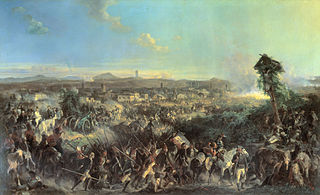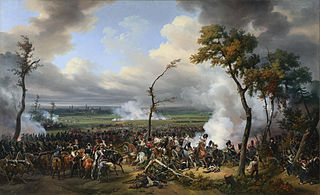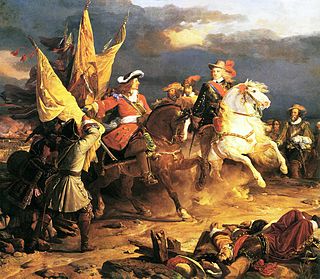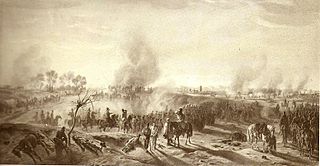
The War of the Austrian Succession was a European conflict that took place between 1740 and 1748. Fought primarily in Central Europe, the Austrian Netherlands, Italy, the Atlantic and Mediterranean, related conflicts included King George's War in North America, the War of Jenkins' Ear, the First Carnatic War and the First and Second Silesian Wars.

The Battle of Mormant was fought during the War of the Sixth Coalition between an Imperial French army under Emperor Napoleon I and a division of Russians under Count Peter Petrovich Pahlen near the town of Mormant, some 50 km (31 mi) southeast of Paris. Pahlen's outnumbered force was enveloped by cavalry and infantry, and nearly destroyed, with only about a third of its soldiers escaping.

The Battle of Novi saw a combined army of the Habsburg monarchy and Imperial Russians under Field Marshal Alexander Suvorov attack a Republican French army under General Barthélemy Catherine Joubert. As soon as Joubert fell during the battle, Jean Victor Marie Moreau immediately took overall command of the French forces. After a prolonged and bloody struggle, the Austro-Russians broke through the French defenses and drove their enemies into a disorderly retreat, while French division commanders Catherine-Dominique de Pérignon and Emmanuel Grouchy were captured. Novi Ligure is in the province of Piedmont in Northern Italy a distance of 58 kilometres (36 mi) north of Genoa. The battle occurred during the War of the Second Coalition which was part of the French Revolutionary Wars.

The Battle of Solferino on 24 June 1859 resulted in the victory of the allied French Army under Napoleon III and Piedmont-Sardinian Army under Victor Emmanuel II against the Austrian Army under Emperor Franz Joseph I. It was the last major battle in world history where all the armies were under the personal command of their monarchs. Perhaps 300,000 soldiers fought in the important battle, the largest since the Battle of Leipzig in 1813. There were about 130,000 Austrian troops and a combined total of 140,000 French and allied Piedmontese troops. After the battle, the Austrian Emperor refrained from further direct command of the army.

The Battle of Neerwinden saw a Republican French army led by Charles François Dumouriez attack a Coalition army commanded by Prince Josias of Saxe-Coburg-Saalfeld. The Coalition army of the Habsburg monarchy together with a small contingent of allied Dutch Republic troops repulsed all French assaults after bitter fighting and Dumouriez conceded defeat, withdrawing from the field. The French position in the Austrian Netherlands swiftly collapsed, ending the threat to the Dutch Republic and allowing Austria to regain control of its lost province. The War of the First Coalition engagement was fought at Neerwinden, located 57 kilometres (35 mi) east of Brussels in present-day Belgium.

The Battle of Oudenarde, also known as the Battle of Oudenaarde, was a major engagement of the War of the Spanish Succession, pitting a Grand Alliance force consisting of eighty thousand men under the command of the Duke of Marlborough and Prince Eugene of Savoy against a French force of eighty-five thousand men under the command of the Duc de Bourgogne and the Duc de Vendôme, the battle resulting in a great victory for the Grand Alliance. The battle was fought near the city of Oudenaarde, at the time part of the Spanish Netherlands, on 11 July 1708. With this victory, the Grand Alliance ensured the fall of various French territories, giving them a significant strategic and tactical advantage during this stage of the war. The battle was fought in the later years of the war, a conflict that had come about as a result of English, Dutch and Habsburg apprehension at the possibility of a Bourbon succeeding the deceased King of Spain, Charles II, and combining their two nations and empires into one.

The Battle of Hanau was fought from 30 to 31 October 1813 between Karl Philipp von Wrede's Austro-Bavarian corps and Napoleon's retreating French during the War of the Sixth Coalition.

The Battle of Piacenza was fought between a Franco-Spanish army and the Austrian army near Piacenza, in Northern Italy on June 16, 1746. It formed part of later operations in the War of the Austrian Succession. The result was a victory for the Austrian forces, led by Prince Josef Wenzel.

The Battle of Bitonto was a Spanish victory over Austrian forces near Bitonto in the Kingdom of Naples in the War of Polish Succession. The battle ended organized Austrian resistance outside a small number of fortresses in the kingdom.

The Battle of Mondovì was fought on 21 April 1796 between the French army of Napoleon Bonaparte and the army of the Kingdom of Sardinia-Piedmont led by Michelangelo Alessandro Colli-Marchi. The French victory meant that they had put the Ligurian Alps behind them, while the plains of Piedmont lay before them. A week later, King Victor Amadeus III sued for peace, taking his kingdom out of the First Coalition. The defeat of their Sardinian ally wrecked the Austrian Habsburg strategy and led to the loss of northwest Italy to the First French Republic.

The Battle of Ebelsberg, known in French accounts as the Battle of Ebersberg, was fought on 3 May 1809 during the War of the Fifth Coalition, part of the Napoleonic Wars. The Austrian left wing under the command of Johann von Hiller took up positions at Ebersberg on the Traun river. The French under André Masséna attacked, crossing a heavily defended 550-meter-long bridge and subsequently conquering the local castle, thus forcing Hiller to withdraw. Ebelsberg is now a southern suburb of Linz, situated on the south bank of the Traun, a short distance above the place where that stream flows into the Danube River.

The Battle of Villaviciosa was a battle between a Franco-Spanish army led by Louis Joseph, Duke of Vendôme and Philip V of Spain and a Habsburg-allied army commanded by Austrian Guido Starhemberg. The battle took place during the War of the Spanish Succession, one day after a Franco-Spanish victory at Brihuega against the British army under James Stanhope. Both Philip V of Spain and the Archduke Charles of Austria claimed victory, but the number of dead and wounded, the number of artillery and other weapons abandoned by the Allied army and the battle's strategic consequences for the war confirmed victory for Philip.

The Battle of Assietta was a significant engagement of the War of the Austrian Succession and pitted a numerically superior French force of 25,000 men under the command of Louis Fouquet, Chevalier de Belle-Isle against a Sardinian army of 15,000 men led by Giovanni Bricherasio. The French were soundly defeated and their commander, Belle-Isle, killed during the course of the battle. The siege was part of the Italian campaign of the War of the Austrian Succession, in which Habsburgs and Bourbons contested for domination over Northern Italy and the various Italian states. The Kingdom of Sardinia joined the war on the side of the Pragmatic Allies in 1742 and rallied itself to Maria Theresa's cause. There also were concerns about growing French influence in its territories. The war in Italy had already been going on for seven years, and the Sardinian army had already suffered several defeats in the field, leading to them opting for a more defensive approach. The French led several expeditions in Italy during the war, combining their forces with the Spanish Bourbons to accomplish their political aims.

The Battle of Loano occurred on 23–24 November 1795 during the War of the First Coalition. The French Army of Italy led by Barthélemy Schérer defeated the combined Austrian and Sardinian forces under Olivier, Count of Wallis.

Ferdinand Charles Gobert, Graf von Aspremont-Lynden-Reckheim (1689–1772), was a soldier, who served in the Low countries for the Habsburgs.
The Battle of Voltri was an engagement occurring on 10 April 1796 during the French Revolutionary Wars and taking place in Voltri, a suburb of Genoa, Italy.

Jean-Jacques Causse was killed in action at the Second Battle of Dego while commanding a French Republican infantry brigade. He joined the French Royal Army and after serving in the ranks for 22 years, gained promotion to officer during the French Revolution. While fighting in the War of the Pyrenees Causse enjoyed rapid advancement, emerging as a general of brigade in December 1793. He transferred to the Army of Italy in February 1795. CAUSSE is one of the names inscribed under the Arc de Triomphe, on Column 30.

The Battle of Epierre was part of a larger War of the First Coalition campaign that pitted a Republican French army led by François Christophe de Kellermann against a numerically stronger Kingdom of Sardinia-Piedmont army commanded by the Prince Maurizio, Duke of Montferrat. Under the overall leadership of the Austrian commander in chief Joseph Nikolaus De Vins, Montferrat launched an offensive in mid-August 1793 to recapture the Duchy of Savoy from the French. Because the French were preoccupied with the Siege of Lyon, the Piedmontese recovered most of the Maurienne and Tarentaise Valleys, but they were stopped just short of Albertville and the reconquest of Savoy. In September, Kellermann launched a counteroffensive in which he adroitly switched his troops between valleys in order to drive back the Piedmontese. At Épierre, the French under Jean-Denis Le Doyen defeated the Marquis of Cordon in a local action. By 8 October the Piedmontese abandoned all their gains and withdrew to the crests of the Graian Alps. In spite of his victory, the suspicious politicians in Paris put Kellermann in arrest and he was imprisoned until November 1794.

The Battle of Volta Mantovana of 1848 was an engagement fought throughout Volta Mantovana on 26 and 27 July 1848 between the Second Austrian army corps of General Konstantin D'Aspré and the 3d Piedmontese division of general Ettore De Sonnaz. It resulted in a decisive Austrian victory.

The Battle of Mortara was a battle between 19,000 Austrian and 26,000 Italian forces on 21 March 1849.




















